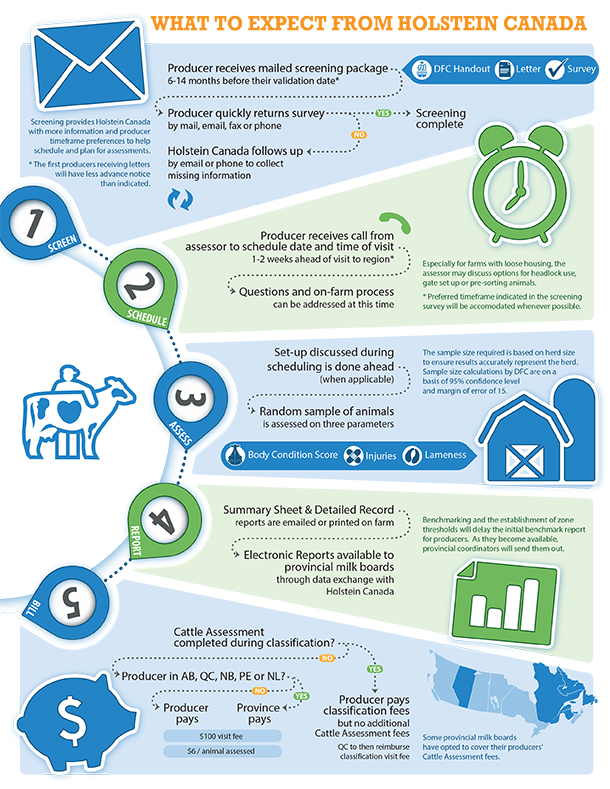The two-year contract will allow time to collect an accurate representation of the dairy herds in Canada, and identify ideal targets and thresholds for herd benchmarking. At the same time, the benchmarking phase will allow Canadian dairy producers to gain a better understanding of the animal care requirements and work towards continuous improvement, if needed.
How does that affect you?
Every dairy farm in Canada has an official anniversary date for the Food Safety Program (previously CQM), and this is also known as your validation date for proAction. As of September 2017, these validations will also include animal care and traceability. That means producers must demonstrate they are meeting the requirements of all three proAction pillars through documented standard operating procedures (SOPs), corrective action plans (CAPs) and reports, and implementation of best management practices.
As it relates to animal care, producers will also need to provide the following documents: cattle assessment summary sheet and cattle assessment detailed report. These two reports will be provided upon the completion of an animal assessment by Holstein Canada and will summarize the overall results of the assessments. The cattle assessment needs to be completed in the 24 months prior to the validation date. At Holstein Canada, it is our intent to offer each producer two to three time frames in which they can have their cattle assessment completed and provide adequate leeway time in hopes of accommodating as many producers as possible. (Barring any changes to the provincial program or validation date.)
What can you expect with the assessment?
1. Screen
In order to schedule an assessment visit, Holstein Canada will first send a screening package by mail. The package will include a DFC informative handout, a letter outlining details of the cattle assessment process, a prescreening survey and a pre-paid envelope to return the survey to the Holstein Canada head office. The survey will enable us to efficiently schedule the assessments with the most relevant and up-to-date information about each farm. Additionally, the survey will contain two to three time frames during which an assessor will likely be in the producer’s region. The producer will then have the opportunity to identify the most convenient time for the cattle assessment. Producers should return this survey by mail, email, fax or phone as soon as possible.
2. Schedule
The assessor will contact the producer one to two weeks ahead of the start of cattle assessments in the area to schedule an appointment. Every effort will be made to perform the cattle assessment during the preferred time frame indicated during the prescreening process. During the scheduling phone call with the assessor, producers are encouraged to ask any questions they may have related to the on-farm process and barn set-up for the cattle assessment. When booking an assessment, please allow adequate time for the assessor to accurately assess the randomly selected sample of lactating animals.
3. Assess
If any set-up changes were discussed with the assessor prior to the visit, in order to respect the schedule and the assessors, producers are kindly asked to complete as much as possible before the assessor is scheduled to arrive at the farm. These tasks may include: setting up extra gates to facilitate smooth cattle movement, locking cattle in headgates, pre-sorting cattle or bringing animals in from the pasture. The required sample size for a cattle assessment is based on herd size. In order to obtain statistically significant results for cattle assessments, smaller herds require a larger proportion of cattle to be assessed. This ensures that a few random animals do not drastically affect the final outcome and that each herd is provided with accurate results.
Each of the sample animals will be assessed on three parameters: body condition score; injuries to the hocks, neck and knees; and lameness. Each trait will be scored on a numeric scale that will deem the trait on that animal as “A” for “acceptable” or “R” for “requires corrective action.” In the case of freestall lameness assessments, there will be a third category, “monitor,” for cattle that are mildly lame.
4. Report
The assessor will leave two documents with the producer, either via email or printed on-farm. In addition to being required by the proAction animal care module, these reports are designed to provide producers with a method of tracking these animal measures over time. Initially, peer benchmarking reports will be made available to producers from their respective milk board provincial coordinators as they become available. They will provide a comparative analysis to their peers, as well as outline areas that achieve optimal scores and areas of potential improvement.
5. Bill
When the cattle assessment is completed during a classification visit, the producer pays the classification fees regularly charged for a classification visit without incurring an extra cost for the cattle assessment.
For Quebec producers, the provincial milk board will reimburse classification visit fees. The provincial milk boards in Alberta, New Brunswick, Newfoundland, Quebec and Prince Edward Island will cover any fees associated with a cattle assessment completed outside of a classification visit. Please note that a visit cancelled less than 24 hours in advance will result in a visit fee charge. Cattle assessment fees for assessments done outside of a classification visit are a $100 visit fee and $6 per animal assessed.
What can you do ahead of time to make sure your cattle assessment is a positive experience for you, your cows and the assessor?
- Prescreening survey: Please fill out completely and return as soon as possible.
- Trimming schedule: Do not schedule your assessment within the week following hoof trimming as trimming may affect cattle gait.
- Cleanliness: To accurately score injuries, the assessor must have a clear view of the area being assessed. If the assessor cannot determine an accurate score due to excessively dirty animals, they may have to score these traits as “R” for “requires corrective action.” If this affects more than 20 percent of the herd, please address this prior to your assessment.
- Preparation: If you and the assessor have planned to have loose-housed animals in headlocks, an extra gate set up or animals in from pasture, please have the set-up complete as much as possible ahead of the visit.
If you have questions about proAction in general, contact your provincial milk board. Specific cattle assessment questions can be directed to Holstein Canada via email or by calling (855) 756-8300 ext. 275. PD
Jeanette Van der Linden and Morgan Overvest are with Holstein Canada.
GRAPHIC: Graphic provided by Holstein Canada.











